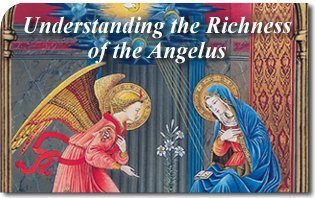 The Angelus is a very brief, eminently logical and well made three-point meditation on the Incarnation.
The Angelus is a very brief, eminently logical and well made three-point meditation on the Incarnation.
The first meditation is: The Angel of the Lord declared unto Mary, and she conceived of the Holy Spirit. The second one is: Behold the handmaid of the Lord, be it done unto me according to thy word. The third is: And the Word was made flesh and dwelt among us.
These three points of meditation are three aspects of the Incarnation. First we glorify the fact that there was an angelic message. Secondly, we recognize Our Lady’s attitude of entire obedience to that angelic message. Finally, we acknowledge the fact that the Word not only became flesh but dwelt among us. This short prayer condenses the whole history of the Incarnation into these three points. It does this in such a condensed, brief, logical and substantial way that nothing more need be added. Each point is followed by the recitation of a Hail Mary, which is a glorification of Our Lady from the standpoint of that truth which the angel announced.
Devotion to the Heart of Mary Will Save the World
Since the fact that the Word became flesh and dwelt among us is precisely the greatest event in the whole history of humanity and the greatest honor ever bestowed upon mankind, it became a habit born of Catholic piety to say the Angelus at dawn, noon and sunset. Thus, we repeat these truths at the three principle stages of the day, praising Our Lady regarding these truths and asking her for graces related to them.
The Angelus, so to speak, changes with the time of day. How beautiful is the Angelus said in the freshness of the morning. How different is the Angelus at noon, when the work pace is intense. When prayed at sunset, everything becomes much more suave and inviting as it begins to take on a tone of recollection.

“L’Angélus” by Jean-François Millet.
The Church takes this jewel, the Angelus, and makes it shine differently as the day progresses as if to draw out all its beauty.
Science Confirms: Angels Took the House of Our Lady of Nazareth to Loreto
We understand how Catholic things, built on Faith and with a kind of instinct from the Holy Ghost to do them well, display a great harmony. For example, the Angelus admirably harmonizes the greatest clemency, simplicity and profoundness of its concepts.
There is also a kind of undefined beauty that comes from its simple poetic and literary elements that does not clash with its deep and profound meaning but, on the contrary, complements it.
Imagine if someone ordered a writer today to compose a prayer to be said every morning, noon and evening, day in, day out, over the ages. Considering the modern mentality, the result would be either a tiny prayer full of trifling and meaningless words or a dry or empty prayer. The prayer would never be able to match the Angelus of Christian piety practiced over the centuries.
 Learn All About the Prophecies of Our Lady of Good Success About Our Times
Learn All About the Prophecies of Our Lady of Good Success About Our Times
What we lack today, especially in Catholic settings, is precisely this kind of spiritual richness whereby one is able to order things with logic, coherence and beauty. However this is done with such naturality that we hardly realize just how well-thought out, well-considered, well-prayed, and above all well-believed all these things are. This can be seen in the Angelus which contains and translates into words the wisdom of the ages.
The preceding text is taken from an informal lecture of Professor Plinio Corrêa de Oliveira. It has been translated and adapted for publication without his revision. –Ed.
Related Articles:
The Annunciation and Saint Gabriel
Two Ways of Looking at Country Life
Being Modern: Apostasy or Sacred Obligation?

